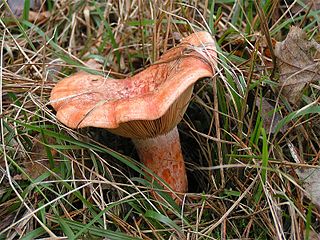
Lactarius deliciosus, commonly known as the delicious milk cap, saffron milk cap and red pine mushroom, is one of the best known members of the large milk-cap genus Lactarius in the order Russulales. It is native to Europe, but has been accidentally introduced to other countries along with pine trees, with which the fungus is symbiotic.

Suillus luteus is a bolete fungus, and the type species of the genus Suillus. A common fungus native all across Eurasia from Ireland to Korea, it has been introduced widely elsewhere, including North and South America, southern Africa, Australia and New Zealand. Commonly referred to as slippery jack or sticky bun in English-speaking countries, its names refer to the brown cap, which is characteristically slimy in wet conditions. The fungus, initially described as Boletus luteus by Carl Linnaeus in 1753, is now classified in a different fungus family as well as genus. Suillus luteus is edible, though not as highly regarded as other bolete mushrooms. It is commonly prepared and eaten in soups, stews or fried dishes. The slime coating, however, may cause indigestion if not removed before eating. It is often sold as a dried mushroom.

Paxillus involutus, also known as the brown roll-rim or the common roll-rim, is a basidiomycete fungus that is widely distributed across the Northern Hemisphere. It has been inadvertently introduced to Australia, New Zealand, South Africa, and South America, probably transported in soil with European trees. Various shades of brown in colour, the fruit body grows up to 6 cm high and has a funnel-shaped cap up to 12 cm wide with a distinctive inrolled rim and decurrent gills that may be pore-like close to the stipe. Although it has gills, it is more closely related to the pored boletes than to typical gilled mushrooms. It was first described by Pierre Bulliard in 1785, and was given its current binomial name by Elias Magnus Fries in 1838. Genetic testing suggests that Paxillus involutus may be a species complex rather than a single species.

Tapinella atrotomentosa, commonly known as the velvet roll-rim or velvet-footed pax, is a species of fungus in the family Tapinellaceae. Although it has gills, it is a member of the pored mushroom order Boletales. August Batsch described the species in 1783. It has been recorded from Asia, Central America, Europe and North America. Tough and inedible, it grows on tree stumps of conifers. The mushroom contains several compounds that act as deterrents of feeding by insects.
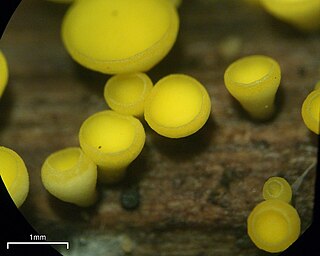
Bisporella citrina, commonly known as yellow fairy cups or lemon discos, is a species of fungus in the family Helotiaceae. The fungus produces tiny yellow cups up to 3 mm in diameter, often without stalks, that fruit in groups or dense clusters on decaying deciduous wood that has lost its bark. The widely distributed species is found in North Africa, Asia, Europe, North America, and Central and South America. Found in late summer and autumn, the fungus is fairly common, but is easily overlooked owing to its small size. There are several similar species that can in most cases be distinguished by differences in color, morphology, or substrate. Microscopically, B. citrina can be distinguished from these lookalikes by its elliptical spores, which have a central partition, and an oil drop at each end.

Hydnellum aurantiacum is an inedible fungus, commonly known as the orange spine or orange hydnellum for its reddish orange or rusty red colored fruit bodies. Like other tooth fungi, it bears a layer of spines rather than gills on the underside of the cap. Due to substantial declines in sightings, this species is listed as critically endangered in the United Kingdom.

Helvella acetabulum is a species of fungus in the family Helvellaceae, order Pezizales. This relatively large cup-shaped fungus is characterized by a tan fruit body with prominent branching ribs resembling a cabbage leaf; for this reason it is commonly known as the cabbage leaf Helvella. Other colloquial names include the vinegar cup and the brown ribbed elfin cup. The fruit bodies reaches dimensions of 8 centimetres (3 in) by 4 cm tall. It is found in Eurasia and North America, where it grows in sandy soils, under both coniferous and deciduous trees.
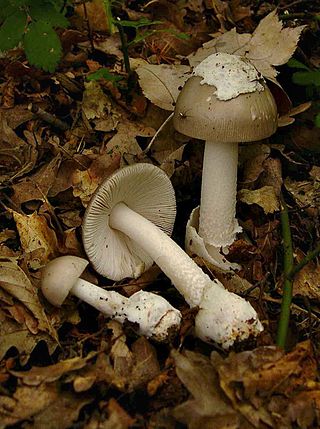
Amanita vaginata, commonly known as the grisette or the grisette amanita, is an edible mushroom in the fungus family Amanitaceae. The cap is gray or brownish, 5 to 10 centimetres in diameter, and has furrows around the edge that duplicate the gill pattern underneath. Unlike many other Amanita mushrooms, A. vaginata lacks a ring on the stem.
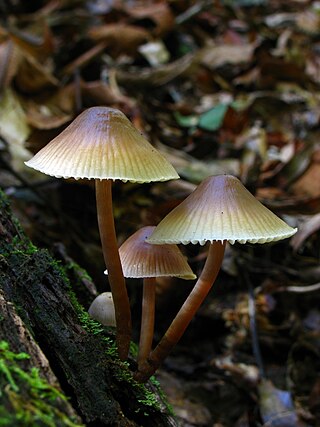
Mycena galericulata is a mushroom species commonly known as the common bonnet, the toque mycena, the common mycena or the rosy-gill fairy helmet. The type species of the genus Mycena was first described scientifically in 1772, but was not considered a Mycena until 1821. It is quite variable in color, size, and shape, which makes it somewhat difficult to reliably identify in the field. The mushrooms have caps with distinct radial grooves, particularly at the margin. The cap's color varies from grayish brown to dark brown and the shape ranges from bell-like to bluntly conical to flattened with an umbo. The stem is hollow, white, tough and thin, without a ring and often roots deeply into the wood on which it grows. The gills are white to grayish or even pinkish when mature and are connected by distinct cross-veins. The caps can reach 4 cm (1.6 in) in diameter, and have a mealy odor and taste. The spore print is white and the gills are pink at maturity, which can lead to possible confusion with species of the genus Pluteus. M. galericulata mushrooms grow mostly in clusters on the well-decayed stumps of deciduous and coniferous trees from spring to autumn. The species can generally be considered inedible. It is common and widespread in the entire temperate zone of the Northern Hemisphere, but it has also been reported from Africa.
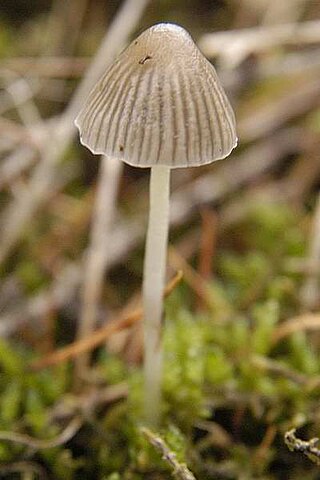
Mycena leptocephala, commonly known as the nitrous bonnet, is a species of fungus in the family Mycenaceae. The mushrooms have conical grayish caps that reach up to 3 cm (1.2 in) in diameter, and thin fragile stems up to 5 cm (2.0 in) long. The gills are gray and distantly spaced. The spores are elliptical, typically measure 7–10 by 4–6 μm, and are white in deposit. When viewed under a light microscope, the gills have abundant spindle-shaped cystidia on the gill edges, but few on the gill faces. The mushroom is found in North America, Asia, and Europe where it grows singly or in groups on conifer needles, cones and sticks on the forest floor. It has a distinctive odor of bleach; the edibility is unknown. Similar species include Mycena alcalina, M. austera, and M. brevipes.

Mycena overholtsii, commonly known as the snowbank fairy helmet or fuzzy foot, is a species of fungus in the family Mycenaceae. The mushrooms produced by the fungus are relatively large for the genus Mycena, with convex grayish caps up to 5 cm (2 in) in diameter and stems up to 15 cm (6 in) long. The gills on the underside of the cap are whitish to pale gray, and initially closely spaced before becoming well-spaced at maturity after the cap enlarges. The mushrooms are characterized by the dense covering of white "hairs" on the base of the stem. M. overholtsii is an example of a snowbank fungus, growing on well-decayed conifer logs near snowbanks, during or just after snowmelt. Formerly known only from high-elevation areas of western North America, particularly the Rocky Mountain and Cascade regions, it was reported for the first time in Japan in 2010. The edibility of the mushroom is unknown. M. overholtsii can be distinguished from other comparable species by differences in location, or spore size.

Plectania nannfeldtii, commonly known as Nannfeldt's Plectania, the black felt cup, or the black snowbank cup fungus, is a species of fungus in the family Sarcosomataceae. The fruit bodies of this species resemble small, black, goblet-shaped shallow cups up to 3 cm wide, with stems up to 4 cm long attached to black mycelia. Fruit bodies, which may appear alone or in groups on the ground in conifer duff, are usually attached to buried woody debris, and are commonly associated with melting snow. Plectania nannfeldtii is found in western North America and in Asia, often at higher elevations. Similar black cup fungi with which P. nannfeldtii may be confused include Pseudoplectania vogesiaca, P. nigrella, and Helvella corium.

Pholiota flammans, commonly known as the yellow pholiota, the flaming Pholiota, or the flame scalecap, is a basidiomycete agaric mushroom of the genus Pholiota. Its fruit body is golden-yellow in color throughout, while its cap and stem are covered in sharp scales. As it is a saprobic fungus, the fruit bodies typically appear in clusters on the stumps of dead coniferous trees. P. flammans is distributed throughout Europe, North America, and Asia in boreal and temperate regions. Its edibility has not been clarified.

Clavaria fragilis, commonly known as fairy fingers, white worm coral, or white spindles, is a species of fungus in the family Clavariaceae. It is synonymous with Clavaria vermicularis. The fungus is the type species of the genus Clavaria and is a typical member of the clavarioid or club fungi. It produces tubular, unbranched, white basidiocarps that typically grow in clusters. The fruit bodies can reach dimensions of 15 cm (5.9 in) tall by 0.5 cm (0.2 in) thick. Clavaria fragilis is a saprobic species, growing in woodland litter or in old, unimproved grassland. It is widespread throughout temperate regions in the Northern Hemisphere, but has also been reported from Australia and South Africa. The fungus is edible, but insubstantial and flavorless. There are several other small white coral-like fungi with which C. fragilis may be confused.

Amanita atkinsoniana, also known as the Atkinson's amanita, is a species of fungus in the family Amanitaceae. The fruit body is white to brownish, with caps up to 12.5 centimetres in diameter, and stems up to 20 cm long. The surface of the cap is covered with brownish conical warts.

Clavariadelphus ligula, commonly known as the strap coral, is a species of fungus in the family Gomphaceae. It produces club-shaped fruit bodies with spongy flesh that grow in groups on the forest floor. It is found in Asia, Europe, and North America.

Collybia cirrhata is a species of fungus in the family Tricholomataceae of the order Agaricales. The species was first described in the scientific literature in 1786, but was not validly named until 1803. Found in Europe, Northern Eurasia, and North America, it is known from temperate, boreal, and alpine or arctic habitats. It is a saprobic species that grows in clusters on the decaying or blackened remains of other mushrooms. The fruit bodies are small, with whitish convex to flattened caps up to 11 mm in diameter, narrow white gills, and slender whitish stems 8–25 mm long and up to 2 mm (0.08 in) thick. C. cirrhata can be distinguished from the other two members of Collybia by the absence of a sclerotium at the base of the stem. The mushroom is of unknown edibility.

Galiella rufa, commonly known as the rubber cup, the rufous rubber cup, or the hairy rubber cup, is a species of fungus in the family Sarcosomataceae. It produces cup-shaped fruit bodies with the texture of tough, gelatinous rubber, with a rough, blackish-brown, felt-like outer surface and a smooth reddish-brown inner surface.

Thelephora palmata commonly known as the fetid false coral or stinking earthfan, is a species of clavarioid fungus in the family Thelephoraceae. The fruit bodies are leathery and coral-like, with branches that are narrow at the base before widening out like a fan and splitting into numerous flattened prongs. The wedge-like tips are whitish when young, but darken as the fungus matures. The common names of the fungus refers to its pungent odor, likened to fetid garlic. A widely distributed but uncommon species, it is found in Asia, Australia, Europe, North America, and South America, where it fruits on the ground in both coniferous and mixed forest.

Protostropharia semiglobata, commonly known as the dung roundhead, the halfglobe mushroom, or the hemispherical stropharia, is an agaric fungus of the family Strophariaceae. A common and widespread species with a cosmopolitan distribution, the fungus produces mushrooms on the dung of various wild and domesticated herbivores. The mushrooms have hemispherical straw yellow to buff-tan caps measuring 1–4 cm (0.4–1.6 in), greyish gills that become dark brown in age, and a slender, smooth stem 3–12 cm (1.2–4.7 in) long with a fragile ring.




















